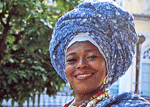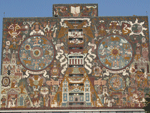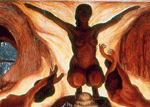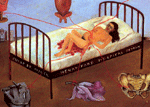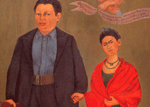Homework #7 From 19th Century to 20th Century and Brazil |
|
Music: There is a link on the HUM2461 Home page for Support Pages, and then there is a link for "Latin American Music and Notes." In these notes there a link for "Latin American Music and Musicians." On this .pdf file go to the notes on "Argentina: Pre-Columbian to Tango." In this section there are notes on tango and the 19th century writer José Hernández. (A) According to these two paragraphs, what is the relationship between (a) tango, (b) what José Hernández wrote, and (c) Argentinian national identity? |
|
Q2. |
Please read the "Notes on 20th and 21st Century Literature (1910 to present)". Notice that this article features seven Latin American writer from the early 20th century. Pick one of the writers to focus your answer on. (A) Tell why you chose this particular writer by citing evidence from these particular "notes" and (B) tell what, in your view, distinguishes that writer as a prominent example of 20th century Latin American humanities, in particular, of course, literature. |
|
Q3. |
(A) In the Index for Brazil, find and review the pages on the Iguaçu Falls; then answer this question: (B) in what way does the presence of the Iguaçu Falls serve the purpose of reinforcing the overall understanding of Latin America and, in particular, Latin American humanities as presented throughout this course? (Note: This question presupposes an understanding of the presentation of Latin American from Day 1 and Day 2 through modernismo and the early 20th century.) |
|
Q4. |
In the Brazil section of Notes on Latin American Music and Musicians in the online textbook, reference is made to "capoeira" music and dance. (A) Briefly describe this music. (B) Then tell what relationship there is between that music and the following image by telling about the Brazilian city (in the Salvador da Bahia subsection of the Brazil Index)where this image is from:
|
|
Q5. |
In the sub-chapter on Rio de Janeiro in the online textbook (See Brazil in the Index), choose one of the 36 images (and some sub-images), and then (A) describe the image and its content and (B) tell what the image you choose says about a significant aspect of Brazilian and Latin American humanities by using one of the course's Key Themes.
|
|
Q6. |
In the online textbook "chapter" on Brazil's capital, there are several places where the Brazilian architect Oscar Niemeyer is discussed briefly. He is one of Latin America's greatest humanists. (A) Describe the style of the humanities objects he created; (B) study the series of the cathedral he designed in Brasilia and describe it in terms of its Brazilian Modernism. | |
Q7. |
In the textbook visual tour with commentaries about Manaus, Brazil (find it in the course Index). Then (A) Answer the questions in Manaus #9. (B) In a short paragraph explain in what way it adds to (expands, enriches) or detracts from your understanding of Latin American humanities. Note: refer to the embedded links before you answer this question. Note also by Dr. Little: I found the presence of this painting (which, to be sure, is not a masterpiece of world art) oddly out of place in this particular museum in this particular city; however, it's presence in this art museum had (has) significance for the patrons of the arts in Manaus. (C) How would you explain this social-cultural-historical fact (i.e., its prominence in this museum), rather than the art itself. |
|
Q8. |
||
Q9. |
In the online textbook's Index for the 20th Century (See "T" in the Index), there is a section on "Notes on the Humanities of the Mexican Revolution." In this section you will find a discussion of the Athenaeum of Mexican Youth (Ateneo de México). Write a brief paragraph in which (A) you place this 1909 institution in its (Mexican) historical context and (B) you describe its central role in a “humanities renaissance” in Mexico and throughout Latin America. |
|
Q10. |
(A) Identify this building and the humanities creator of the murals that cover it. (B) Answer 2 of the HUM 2461 questions in the series (A - E) embedded in Juan O'Gorman #7. Identify exactly which questions you choose to answer. (Find the section on Juan O'Gorman, Mexican muralist).
|
|
Q11. |
Study Diego Rivera's self-portraits 1-5 (find them in the the link in Diego Rivera #2) and then answer this question: pick one of Rivera's self-portraits that strikes you most and tell what you think about this particular image and this particular artist. |
|
Q12. |
||
Q13. |
(A) Identify this rather disturbing painting and its creator. (B) Describe its most important features of content and style, and (C) briefly say what the relationship is between this painting and the art works in Diego Rivera #28 and #32.
|
|
Q14. |
(A) Identify the figures in this image (painting) and who the artist (humanist) is; (B) The artist is providing the perspective, right? What is this perspective and what does the perspective contribute to an understanding of the painting? (C) What do you think personally about the two people figured in this painting?
|
|
Q15. (1 point extra credit for all 4 answers) |
Study the statement and the paintings about the contemporary French-Canadian (Québécois) painter Pierre Gauvreau ("G" in the Index). Then pick one of the paintings that you find most interesting. (A) Describe the painting. (B) In what way do you see that this painting and this painter are clearly Latin American (remember that French is a Latin language and French culture is also "Latin" and Québec is located in the Americas. (C) Tell why the painting you choose is "modern". (D). Give your own impression or feeling about the painting; i.e., react personally. |
